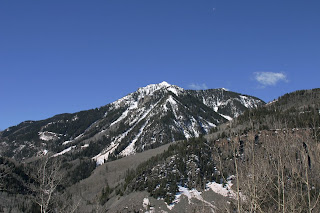First of all, note the half moon near the top of the picture. It seems awfully small. Perhaps the atmosphere at this altitude doesn't magnify it as much as at lower levels. . . any comments?
One overall impression I have from my travels hither and yon is a marked difference between the Rockies and the Smokies (or Appalacians, if you prefer). I suppose it all has to do with altitude but, back east we see rock faces where engineers have carved roads out of the wilderness - and occasionally a monolith like Stone Mountain or Looking Glass Mountain. Out here, you have the roadside rock faces as well and, of course, the mountain tops regularly seem to be poking out of their skins. But elsewhere there seems to be just a lot of exposed rock that, had it been in the carolinas, would probably be covered with grass - or at the very least, moss. It's not a complaint, just an observation. I guess that's why they're called the Rockies. I'm not sure just where I'd put the Sierra Nevada; but it didn't give me the same impression.
Just look at all that bare rock! It's as though Colorado's got more mountains than it can properly cover...
But it certainly knows how to do a vista in fine style when it wants to.




Comment on moon size in second picture — your thin air hypothesis is, no doubt, based on sound logic. Of course, as you know, there are other factors involved. One is that the higher in the sky the moon gets, the smaller it looks, at any altitude. This is due to a phenomenon closely related to your own argument — in this case that the view at a higher point in the sky is less magnified than a view looking through the thicker lens of atmosphere nearer the horizon (celestial objects viewed near the horizon are viewed through the atmosphere at an oblique angle, constituting said thicker lens). The moon in this picture is getting up there, you might say.
ReplyDeleteIn addition to all this, as long as I've taken pictures, I've almost always been surprised at the smallish scale of the moon in my own shots (always wanted a 1000 mm zoom). Assuming that others have observed the same thing in their own moon photos, your hypothesis would have to take into account that the moon in most photos usually does appear smaller than one would expect, before crediting your conjecture as the answer to the scale question.
So, if I had to give one answer as the most worthy, I would have to give a third, rather obvious one — the focal length at which the image was captured. Since I don't know the focal length of this image, however, nor of any of my own, I can't make any worthwhile comparisons. (If you can access the meta data for moon images you've taken at different altitudes, but under otherwise similar condiions, you might learns something worthwhile.)
Oh, one more question worth consideration — does the moon look farther away when it actually is? In other words, is its fluctuating distance from earth a significant factor in its perceived size in the sky?
So many questions, so little time.